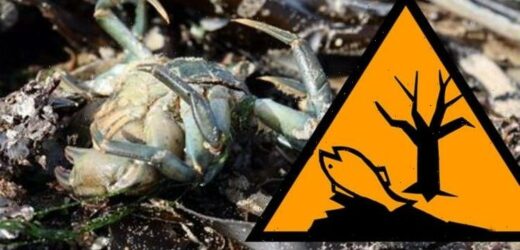Brexit: Fishing industry was 'sacrificed' by government says Deas
We use your sign-up to provide content in ways you’ve consented to and to improve our understanding of you. This may include adverts from us and 3rd parties based on our understanding. You can unsubscribe at any time. More info
Last week, a report from the Department of Environment, Food and Rural Affairs (DEFRA) uncovered a probable cause for the mysterious deaths of crabs and lobsters in the North Sea. This mysterious phenomenon was taking place along the North East coast and was causing stocks to be wiped out. The Government agency believes that the deaths of the crabs and lobsters between October and December 2021 potentially resulted from a naturally occurring harmful algal bloom.
However, an independent study linked these mass crustacean deaths to chemicals released during the dredging of the River Tees.
This report raises concerns over the Government’s flagship freeport on Teesside, which is a key part of Brexit Britians “levelling up agenda”.
Reports estimate that this freeport will help create 18,000 new jobs and boost the economy by £3.2billion.
Over the past few months, tens of thousands of crabs and lobsters were found dead on beaches up and down the North East of England.


These deaths caused fishermen to fear for their livelihood as government agencies including DEFRA and the Centre for Environment, Fisheries and Aquaculture (CEFAS) scrambled to find an explanation for the phenomenon.
From the beginning, fishermen have alleged that these deaths may be linked to the dredging of the River Tees, which the Government denied.
Now, the independent report seems to back up the claims made by the fishermen.
Tim Deere-Jones, an independent marine pollution consultant and author of the report, said there was “no empirical evidence to support the theory that it’s got anything to do with an algal bloom”.

Mr Deere-Jones, who has 30 years of experience around dredging issues as a consultant, said that the data obtained from DEFRA via freedom of information requests and other agencies have linked the mass mortalities of crabs to a specific chemical, pyridine.
Pyridine is a chemical that is used as a base in pesticides and can be released into the environment as a waste product from industrial processes.
He warned: “So far, the available evidence points clearly to pyridine as a potential cause of the mortality.”
Mr Deere-Jones’s analysis found several potential sources of pyridine discharge to the estuary.
DON’T MISS:
Putin strikes! Russia cuts gas supply after Biden’s troops make ‘de… [INSIGHT]
Black hole warning as rogue body spotted wandering Milky Way [REVEAL]
Biden makes move as Putin warned he risks losing ‘cash cow’ [SPOTLIGHT]


These sources could be a few decades old, but have now been embedded deep into the seabed.
He added: “On the basis of the established fact that pyridine preferentially deposits out into estuarine sediments, rather than remains in the water column, it seems likely that the new deeper dredging being constructed has uncovered and redistributed pyridine-laced sediments to the regional marine environment.”
Defra noted that “any levels [of pyridine] detected in crab tissue are likely to be linked to biological processes and not necessarily from the environment.”
However, Mr Deere-Jones pointed out that the Saltburn crabs were found to have more than 400mg per kg of Pyridine
He said: “That’s not a natural level, that’s a human impact level.”
Source: Read Full Article


